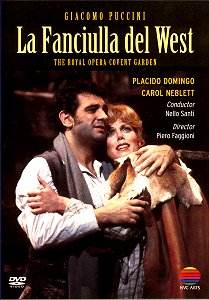When NVC Arts first released The Girl of the
Golden West on videocassette there were no subtitles. This
made it very difficult to follow the intricacies (especially of
Act I) of Puccini’s, later, less popular opera. Now in its new
DVD format with enhanced pictures and sound, and subtitles, this
acclaimed 1983 Royal Opera House production really comes to life.
But I still have a gripe. Although this DVD release comes with
subtitles there is a woeful lack of documentation, only a track
listing and a skimpy synopsis; there’s not even a cast list!
After the successes of La Bohème, Tosca,
and Madama Butterfly, Puccini strengthened his resolve
to make La fanciulla del West a different kind of opera
from which all elements of sweetness would be ruthlessly expunged.
It would also, unusually for Puccini, have its main protagonists,
Dick Johnson (Ramirez) and Minnie leave the stage alive at the
end. No heroine as victim this time; for Minnie knows exactly
how to control and manipulate the men around her. She, and no
other female, dominates this opera (all other female roles are
minor and either off-stage or well into the background).
Although the melodies in The Girl of the Golden
West are not so immediately appealing (no interruptions for
applause are heard in this performance), nevertheless the opera
has plenty of harmonic and instrumental innovations and plenty
of action to sustain interest. Puccini himself recommended two
or three hearings to get to know La fanciulla del West
properly. Ravel perceptively recognised that here was a work in
which Puccini had put the orchestra in the role of the protagonist;
and one might note that the sound-world of Debussy rather than
Richard Strauss is sometimes evoked in this opera.
Visually this Royal Opera House production is
most pleasing: conventional sets, easily recognisable from countless
western films. Minnie’s saloon bar spaciously appointed adds just
the right atmosphere for the crowded Act I . A shallower set,
for Minnie’s cabin is appropriate for the more intimate proceedings
of Act II. The wintry exterior of the mine entrance is appropriately
bleak and dramatic for the playing out of the concluding act.
A youthful Placido Domingo makes a dashing Dick
Johnson his greed turned to love on meeting Minnie. His final
act aria in which he appeals to the mob not to tell Minnie that
they have hanged him but rather let her believe that he has ridden
away remorseful to a new life is particularly appealing. As Conrad
Wilson says in his fine book, Giacomo Puccini, after
two stanzas of this eloquent two-stanza lament, Sheriff Rance
– the Californian equivalent of Scarpia in Tosca – replies by
punching Dick in the face. "Because it comes so late in the
opera, the aria is all the more potent in its effect. It is music
more succinct, and more subtle than Cavaradossi’s comparable ‘E
lucevan le stelle’ in Tosca. It also, like the rest of
La fanciulla requires its listeners to use their ears."
Silvano Carroli is a splendidly jealous Sheriff
Jack Rance, his every oily gesture oozing ill-concealed menace.
Mention must be made of Robert Lloyd, a strong, unrelenting Ashby,
the Wells Fargo man and of Gwynne Howell, in his first act cameo
as Jack Wallace the mining camp’s minstrel who sings so sentimentally,
so nostalgically of home to the work-weary miners. The rest of
the supporting cast and the Royal Opera Chorus impress strongly
too.
In the title role Carol Neblett is ideally cast
as the feisty but sincere, even motherly (to the miners who let
her outlaw go at the end) Minnie. Her singing is rich and true
with tremendous attack and confidence on her exposed high notes.
Despite skimpy documentation support, this is
a very pleasing performance of one of Puccini’s later operas –
a work that appeals more with every hearing. Domingo and Neblett
are on top form.
Ian Lace
